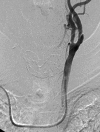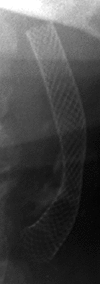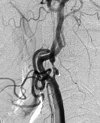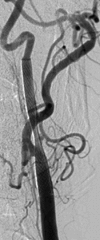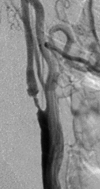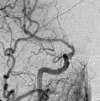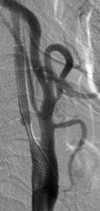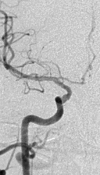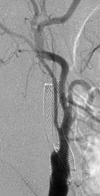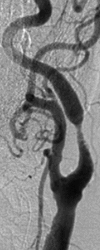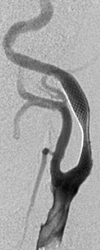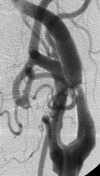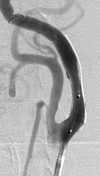Carotid Stenting without Angioplasty and without Protection: The Advantages of a Less Invasive Procedure
- PMID: 20557756
- PMCID: PMC3313718
- DOI: 10.1177/159101990801400206
Carotid Stenting without Angioplasty and without Protection: The Advantages of a Less Invasive Procedure
Abstract
Endovascular stenting is a consolidated alternative to thrombendarterectomy in the treatment of extracranial carotid artery atheromasic stenosis. The most common complication of stenting is a distal embolism causing clinically silent orsymptomatic cerebral ischaemia. To prevent this complication distal embolism protection devices are often used but their effectiveness remains unsettled. In addition, there is some evidence that distal embolism may actually be triggered by the protection systems due to clot formationat their distal surface or in the intimal lesions these systems cause. Another rarer complicationis hyperperfusion syndrome arising during both stenting and thrombendarterectomy but more common in endovascular procedures. To avoid these complications the Neuroradiology Service at Bellaria Hospital (Bologna Local Health Trust) has devised a mini-invasive carotid stenting technique that does not require either distal embolism protection or angioplasty. The technique uses only the radial force exerted by the self-expanding stent to widen the atherosclerotic stenosis slowly and gradually. The goal of treatment has also changed from a prompt restoration of the atheromasic vessel's original calibre to slow transformation of the hemodynamic significance of the stenosis. The technique's success lies mainly in selecting the stenosis to treat using CT angiography to analyse plaque morphology and structure.We used the technique to treat 83 stenotic lesions in 75 patients. The study aims to describe and discussour experience.
Figures
Similar articles
-
[The cerebral protection technique in angioplasty plus stenting of carotid: an effective procedure against cerebral embolism].Arq Neuropsiquiatr. 2003 Jun;61(2A):296-302. doi: 10.1590/s0004-282x2003000200028. Epub 2003 Jun 9. Arq Neuropsiquiatr. 2003. PMID: 12806517 Portuguese.
-
Transfemoral endovascular treatment of atherosclerotic stenotic lesions of the left common carotid artery ostium: case series and review of the literature.J Neurointerv Surg. 2013 Nov;5(6):539-42. doi: 10.1136/neurintsurg-2012-010523. Epub 2012 Nov 2. J Neurointerv Surg. 2013. PMID: 23125427
-
[Clinical analysis of carotid angioplasty stenting for high-grade extracranial carotid artery stenosis combined with severe tortuosity].Zhonghua Yi Xue Za Zhi. 2015 Jul 7;95(25):1980-5. Zhonghua Yi Xue Za Zhi. 2015. PMID: 26710804 Chinese.
-
Stenting for Internal Carotid Artery Stenosis Associated with Persistent Primitive Hypoglossal Artery Using Proximal Flow Blockade and Distal Protection System: A Technical Case Report and Literature Review.J Stroke Cerebrovasc Dis. 2016 Jun;25(6):e98-e102. doi: 10.1016/j.jstrokecerebrovasdis.2016.03.026. Epub 2016 Apr 19. J Stroke Cerebrovasc Dis. 2016. PMID: 27105567 Review.
-
[Endovascular treatment for carotid artery stenosis].Brain Nerve. 2010 Dec;62(12):1291-300. Brain Nerve. 2010. PMID: 21139182 Review. Japanese.
Cited by
-
Complications of carotid angioplasty and stenting.AJNR Am J Neuroradiol. 2012 Aug;33(7):E109. doi: 10.3174/ajnr.A3213. Epub 2012 Jul 5. AJNR Am J Neuroradiol. 2012. PMID: 22766679 Free PMC article. No abstract available.
-
Letter - Re: Primary carotid stenting without angioplasty.Interv Neuroradiol. 2008 Dec 29;14(4):473. Epub 2009 Jan 5. Interv Neuroradiol. 2008. PMID: 20557751 Free PMC article. No abstract available.
-
Reversible and Asymptomatic Gyral and Subarachnoid Contrast Enhancement after Carotid Stenting.Neuroradiol J. 2015 Apr;28(2):184-6. doi: 10.1177/1971400915576630. Epub 2015 Apr 13. Neuroradiol J. 2015. PMID: 25923674 Free PMC article.
References
-
- Derubertis BG, Chaer RA, et al. Evolution of the treatment of carotid occlusive disease: indications for carotid angioplasty and stenting versus carotid endoarterectomy. Journal Cardiovascular Surgery. 2006;47:297–303. - PubMed
-
- CAVATAS Investigators Endovascular versus surgical treatment in patients with carotid stenosis in the Carotid and Vertebral Artery Transluminal Angioplasty Study (CAVATAS): a randomized trial. Lancet. 2001;357:1729–1737. - PubMed
-
- Naylor AR, Rothwell PM, Bell PRF. Overview of the principal results and secondary analyses from the European and the North American randomised trials of carotid endoarterectomy. European Journal Endovascular Surgery. 2003;26:115–119. - PubMed
-
- Albert MJ. WALLSTENT. Results of a multicenter prospective randomized trisl of carotid artery stenting versus carotid endoarterectomy. Stroke. 2001;32:325.
-
- Ouriel K, Yadav J, et al. SAPPHIRE randomised trial of carotid stenting versus endarterectomy: a subgroup analysis.; Proceedings of the Annual Meeting of the Society for Vascular Surgery and the American Association of Vascular Surgeons.; 2003, 8th-11th June; Chicago. 2003.
LinkOut - more resources
Full Text Sources


